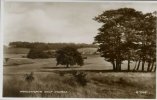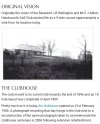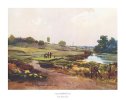-
Welcome to this forum . We are a worldwide group with a common interest in Birmingham and its history. While here, please follow a few simple rules. We ask that you respect other members, thank those who have helped you and please keep your contributions on-topic with the thread.
We do hope you enjoy your visit. BHF Admin Team
You are using an out of date browser. It may not display this or other websites correctly.
You should upgrade or use an alternative browser.
You should upgrade or use an alternative browser.
Handsworth Golf Club
- Thread starter Vivienne14
- Start date
This is a description of the course from The Golf Courses of the British Isles by Bernard Darwin, 1910
Not far from Sandwell Park is another very well-known Birmingham course, Handsworth. This is the home green of that keenest and most persevering of golfers, Mr. C.A. Palmer; he has tried as hard over his own course as he did over his own game, and the system of bunkers, for which he has chiefly been responsible, is marked by a great deal of skill and ingenuity. The course is undoubtedly a good sound test of golf, and there is one type of golfer who will be tested out of his seven senses, and that is the victim of a chronic slice. All along the right-hand side of the course there runs an out-of-bounds area, so that the poor slicer is for ever dropping another ball over his shoulder.
Another hazard that plays an important part, especially in those holes that come in the middle of the round, is a stream. Full and ingenious use has been made of this stream, and there is a good deal of rather cunning pitching to be done in order to circumvent it; anything in the nature of a running shot is, naturally enough, at a discount.
The course begins quite excellently, and the first two holes are two of the best on the way out. At the first there is a big pool on the right and a generous supply of bunkers on the left, so that the very first tee-shot of the day has to be hit quite unpleasantly straight. If it is so hit, an iron shot of moderate length should see us safely on the green with the orthodox two putts for a four; if it is not, it would be rash to dogmatize as to what our precise score may be. The second hole, again, has one of those interesting carries from the tee that the player can make just as short or as long as he likes, according as his tactics are those of Fabius or some more dashing hero. The green lies on a hill-top some 380 yards away from the tee, and a bold tee-shot, followed by a really well-struck second, may make a four hole of it, but it is a good four.
The sixth is another good hole, although there is rather an aggravating cart track at just such a distance from the tee as to be likely to trap a respectable shot. The green, moreover, is very well guarded by a brook on the left and some pot-bunkers on the right. At the eighth we come to the first of the regular short holes, of which there are three in all, though there are two more which may on occasion be reached with a particularly shrewd blow, and it may be said in parenthesis that it is something of a weakness in the course that none of the three can be called passionately interesting.
It is to be hoped that we get a three at this eighth, for we shall need a little cheering before facing the prospect of real, honest hitting at the next three holes. The ninth is well over four hundred yards long, and we begin the homeward round with a five-hundred-yarder, or something very little short of it. It is not a very thrilling hole, however, and the fourteenth and seventeenth, both good two-shot holes, are certainly more interesting, and perhaps the best in the homeward nine.
The whole course is in good order, and the greens thoroughly well kept, although they are perhaps rather lacking in variety and err on the side of flatness. The soil is good and light, and that is no small thing to be thankful for in the very centre of England, when the nearest seaside golf is as far off as the coast of Wales.
Not far from Sandwell Park is another very well-known Birmingham course, Handsworth. This is the home green of that keenest and most persevering of golfers, Mr. C.A. Palmer; he has tried as hard over his own course as he did over his own game, and the system of bunkers, for which he has chiefly been responsible, is marked by a great deal of skill and ingenuity. The course is undoubtedly a good sound test of golf, and there is one type of golfer who will be tested out of his seven senses, and that is the victim of a chronic slice. All along the right-hand side of the course there runs an out-of-bounds area, so that the poor slicer is for ever dropping another ball over his shoulder.
Another hazard that plays an important part, especially in those holes that come in the middle of the round, is a stream. Full and ingenious use has been made of this stream, and there is a good deal of rather cunning pitching to be done in order to circumvent it; anything in the nature of a running shot is, naturally enough, at a discount.
The course begins quite excellently, and the first two holes are two of the best on the way out. At the first there is a big pool on the right and a generous supply of bunkers on the left, so that the very first tee-shot of the day has to be hit quite unpleasantly straight. If it is so hit, an iron shot of moderate length should see us safely on the green with the orthodox two putts for a four; if it is not, it would be rash to dogmatize as to what our precise score may be. The second hole, again, has one of those interesting carries from the tee that the player can make just as short or as long as he likes, according as his tactics are those of Fabius or some more dashing hero. The green lies on a hill-top some 380 yards away from the tee, and a bold tee-shot, followed by a really well-struck second, may make a four hole of it, but it is a good four.
The sixth is another good hole, although there is rather an aggravating cart track at just such a distance from the tee as to be likely to trap a respectable shot. The green, moreover, is very well guarded by a brook on the left and some pot-bunkers on the right. At the eighth we come to the first of the regular short holes, of which there are three in all, though there are two more which may on occasion be reached with a particularly shrewd blow, and it may be said in parenthesis that it is something of a weakness in the course that none of the three can be called passionately interesting.
It is to be hoped that we get a three at this eighth, for we shall need a little cheering before facing the prospect of real, honest hitting at the next three holes. The ninth is well over four hundred yards long, and we begin the homeward round with a five-hundred-yarder, or something very little short of it. It is not a very thrilling hole, however, and the fourteenth and seventeenth, both good two-shot holes, are certainly more interesting, and perhaps the best in the homeward nine.
The whole course is in good order, and the greens thoroughly well kept, although they are perhaps rather lacking in variety and err on the side of flatness. The soil is good and light, and that is no small thing to be thankful for in the very centre of England, when the nearest seaside golf is as far off as the coast of Wales.
I know the Golf Course, when I lived off Friary Road in Handsworth Wood I sometimes used to walk onto the fields at the end of Silvercroft Avenue where you could walk right across to Sandwell Valley Park, passing the Golf Course.
it looks a nice area sparks and still there
Handsworth Golf Club - Handsworth Golf Club
Widely recognised as a hidden gem, Handsworth Golf Club offers an excellent golf course and an ideal venue for individuals, societies and corporate clients.
Richard Dye
master brummie
I didn’t play golf when I lived there and did not know the club.
During my adult life I have played many courses some not so good and some world class.
Looking at the the course, fee schedule and facilities, this looks like a diamond in to rough! That fact that it has corporate memberships is a big plus. While golf is not growing like once was , if you look at the cost per hour for recreation, that’s pretty darn good.
Thank you for sharing, and I like Lyn didn’t know it was there!
During my adult life I have played many courses some not so good and some world class.
Looking at the the course, fee schedule and facilities, this looks like a diamond in to rough! That fact that it has corporate memberships is a big plus. While golf is not growing like once was , if you look at the cost per hour for recreation, that’s pretty darn good.
Thank you for sharing, and I like Lyn didn’t know it was there!
Richard Dye
master brummie
I didn’t play golf when I lived there and did not know the club.
During my adult life I have played many courses some not so good and some world class.
Looking at the the course, fee schedule and facilities, this looks like a diamond in to rough! That fact that it has corporate memberships is a big plus. While golf is not growing like once was , if you look at the cost per hour for recreation, that’s pretty darn good.
Thank you for sharing, and I like Lyn didn’t know it was there!
During my adult life I have played many courses some not so good and some world class.
Looking at the the course, fee schedule and facilities, this looks like a diamond in to rough! That fact that it has corporate memberships is a big plus. While golf is not growing like once was , if you look at the cost per hour for recreation, that’s pretty darn good.
Thank you for sharing, and I like Lyn didn’t know it was there!
Further to my previous post. I have found the following from "A brief history of the Midland Gliding Club" (1) & "UK Airfields & Airports" (2) :
"a training ground was acquired at Handsworth, Birmingham where pilots enjoyed very short downhill flights in bungee launched primary gliders. At the start of WWII use of the training ground ceased as did activities on the Mynd. For the two years immediately prior to the war Amy Johnson was a member of the Club."
"The airfield was located on what is now Handsworth Golf Club."
Links:
https://www.midlandgliding.club/wp-content/uploads/2015/05/mgc_history_v2.pdf
"a training ground was acquired at Handsworth, Birmingham where pilots enjoyed very short downhill flights in bungee launched primary gliders. At the start of WWII use of the training ground ceased as did activities on the Mynd. For the two years immediately prior to the war Amy Johnson was a member of the Club."
"The airfield was located on what is now Handsworth Golf Club."
Links:
https://www.midlandgliding.club/wp-content/uploads/2015/05/mgc_history_v2.pdf



